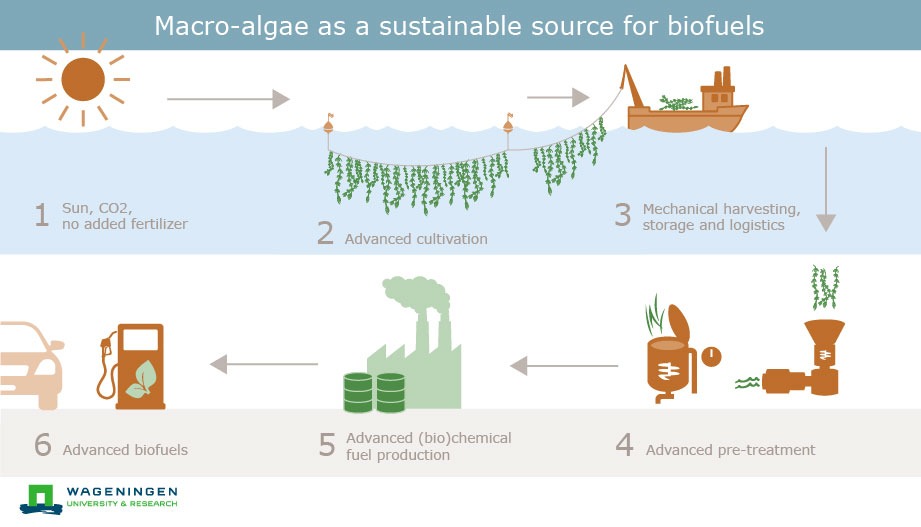How It Works
Ocean BioEnergy
Ocean BioEnergy from Sargassum refers to the potential use of Sargassum seaweed, a type of brown macroalgae that floats in large mats in the ocean, as a source of renewable energy.
Sargassum seaweed is abundant in the tropical and subtropical waters of the Atlantic Ocean, Caribbean Sea, and Gulf of Mexico, and its biomass can be harvested and processed into biofuels, biogas, and other forms of energy.
Ocean BioEnergy: Turning Bad Weed into Power

Introduction
The world is currently facing a significant challenge in meeting its energy demands while reducing its carbon footprint. The use of fossil fuels for energy production is a major contributor to climate change, which is one of the most pressing environmental issues of our time. To address this challenge, renewable energy sources such as wind, solar, and hydropower have gained significant attention in recent years. However, another promising source of renewable energy that has gained attention is Ocean Bioenergy from Sargassum seaweed.
Sargassum seaweed is a brown macroalga abundant in the tropical and subtropical waters of the Atlantic Ocean, Caribbean Sea, and Gulf of Mexico. Its biomass can be harvested and processed into biofuels, biogas, and other forms of energy. This paper explores the potential of creating Ocean Bioenergy from Sargassum seaweed, its advantages, challenges, and ongoing research.
Advantages of Sargassum Seaweed as a Source of Ocean Bioenergy
There are several advantages to using Sargassum seaweed as a source of Ocean Bioenergy. One of the primary advantages is its high growth rate. Sargassum can grow up to 60 cm in length in just one week, making it a highly productive and renewable resource for energy production. Additionally, Sargassum requires few nutrients to grow and can absorb carbon dioxide from the atmosphere, making it an environmentally sustainable resource.
Another advantage of using Sargassum seaweed as a source of Ocean Bioenergy is its potential to reduce reliance on fossil fuels. The production of biofuels from Sargassum seaweed can help to reduce greenhouse gas emissions and improve energy security. Furthermore, Sargassum seaweed can be grown in coastal areas, providing economic opportunities for communities and creating local jobs.
Challenges of Creating Ocean Bioenergy from Sargassum Seaweed
Despite its many advantages, several challenges are associated with creating Ocean Bioenergy from Sargassum seaweed. One of the primary challenges is the harvesting process. Sargassum seaweed is a free-floating alga, making it difficult to harvest. The harvesting process requires specialized equipment and skilled labor, which can be costly.
Transportation and storage are other challenges associated with Sargassum seaweed as a source of Ocean Bioenergy. Due to its high moisture content, Sargassum seaweed requires careful handling and storage to prevent degradation and spoilage.
Additionally, the environmental impact of harvesting Sargassum seaweed must be carefully considered. Sargassum seaweed provides a habitat for a wide range of marine species, including sea turtles, crabs, and fish. The removal of large quantities of Sargassum seaweed could have significant impacts on these marine ecosystems.
Ongoing Research
Despite the challenges, research and development efforts are ongoing to explore the potential of creating Ocean Bioenergy from Sargassum seaweed. Several studies have been conducted on the feasibility of using Sargassum seaweed for energy production, including the production of biogas, biofuels, and other forms of energy.
In a study conducted by Liu et al. (2019), Sargassum seaweed was used as a feedstock for the production of biogas. The study found that Sargassum seaweed was an effective substrate for biogas production, with a high methane yield.
Another study by Tsai et al. (2017) explored the potential of using Sargassum seaweed as a feedstock for the production of biofuels. The study found that Sargassum seaweed was a promising feedstock for biofuel production, with a high yield of lipids that could be converted into biodiesel.
Conclusion
In conclusion, the creation of Ocean Bioenergy from Sargassum seaweed is a promising source of renewable energy. Sargassum seaweed has several advantages as a bioenergy feedstock, including its high growth rate, low nutrient requirements, and ability to absorb atmospheric carbon dioxide. However, there are also challenges associated with harvesting, processing, and transporting seaweed and potential environmental impacts on marine ecosystems.
Despite these challenges, ongoing research and development efforts are exploring the potential of Sargassum seaweed as a source of Ocean Bioenergy. The results of these studies suggest that Sargassum seaweed has significant potential as a renewable energy source, with high yields of biogas and biofuels.
As the world continues to transition towards renewable energy sources, the development of Ocean Bioenergy from Sargassum seaweed can play a vital role in reducing our reliance on fossil fuels and mitigating climate change. However, further research is needed to address the challenges associated with Sargassum seaweed as a bioenergy feedstock and ensure its sustainable use.
References:
Liu, H., Sun, Y., Guo, Y., Wang, X., & Sun, C. (2019). Biogas production from Sargassum fusiforme based on anaerobic digestion. Journal of Cleaner Production, 235, 1149-1156.
Tsai, Y., Chang, Y., Hsu, C., & Hu, I. (2017). Feasibility study of lipids extracted from Sargassum spp. as a biodiesel feedstock. Renewable Energy, 105, 492-498.
The Island Promise
Sargassum has been studied for its potential as an energy source for several decades, but its use as a renewable energy source is still in the experimental stages.
Early research: In the 1980s, researchers began investigating the potential of sargassum as a source of biofuel. Initial studies focused on the species Sargassum fluitans and Sargassum natans, which are abundant in the Sargasso Sea in the North Atlantic Ocean.
Algal biofuels: In the early 2000s, as interest in renewable energy grew, research on sargassum expanded to include the development of algal biofuels. Researchers found that sargassum has a high growth rate and can be grown in a variety of conditions, making it a promising source of biomass for biofuels.
Orozco-González, Jorge Gabriel (2022)
Opportunities Surrounding the Use of Sargassum Biomass as Precursor of Biogas, Bioethanol, and Biodiesel Production
Climate change (along with other factors) has caused an increase in the proliferation of brown algal mats floating freely along the Atlantic Ocean since 2011. These brown algae mats are composed of sea plants from the Sargassum genus.
Zhao, Yiru, Bourgougnon, et al. (2022)
Biofuel Production from Seaweeds: A Comprehensive Review
Seaweeds represent a promising and sustainable feedstock for biofuel production which raises increasing research interests. Their high availability, easy fermentable composition, and good degradation potential make them a suitable candidate for alternating fossil fuels as an advantageous energy resource.

FAQ
What are Sargassum as ocean bioenergy?
Sargassum is a type of brown seaweed that has been studied for its potential as a source of ocean bioenergy. Ocean bioenergy refers to the energy that can be generated from the renewable resources found in the ocean, such as waves, tides, and ocean currents, as well as marine biomass like seaweed.
Sargassum is particularly promising for bioenergy production due to its high growth rate, which enables it to rapidly produce large amounts of biomass. Additionally, sargassum is able to absorb nutrients and carbon dioxide from seawater, making it an attractive option for carbon sequestration and nutrient remediation in marine environments.
How does Sargassum as ocean bioenergy work?
Sargassum can be used to generate ocean bioenergy through several different processes. Here are a few examples:
- Anaerobic digestion: Sargassum biomass can be converted into biogas through anaerobic digestion. This involves breaking down the organic matter in the sargassum in the absence of oxygen, which produces a mixture of methane and carbon dioxide. This biogas can be captured and used as a fuel for heating or electricity generation.
- Fermentation: Sargassum biomass can also be converted into biofuels like ethanol through fermentation. This process involves breaking down the sugars in the sargassum into alcohol through the action of yeast or other microorganisms. The resulting biofuels can be used as a renewable alternative to fossil fuels.
- Direct combustion: Sargassum biomass can be burned directly to produce heat or electricity. This involves heating the biomass to a high temperature in the presence of oxygen, which releases the energy stored in the organic matter as heat. The heat can be used directly for heating or cooking, or it can be used to generate electricity in a steam turbine.
The exact process used to generate ocean bioenergy from sargassum will depend on a variety of factors, including the location and abundance of sargassum, the infrastructure available for harvesting and processing the seaweed, and the specific energy needs of the surrounding community. However, sargassum has shown great promise as a renewable source of ocean bioenergy, with the potential to help meet the world’s growing demand for sustainable energy while also helping to mitigate climate change by reducing greenhouse gas emissions
What are the advantages of Sargassum as ocean bioenergy?
There are several potential advantages of using sargassum as ocean bioenergy:
-
Renewable and sustainable: Sargassum is a renewable resource that can be grown and harvested without depleting natural resources. Unlike fossil fuels, sargassum biomass can be continually replenished through sustainable cultivation and harvesting practices.
-
High growth rate: Sargassum has a high growth rate, meaning it can rapidly produce large amounts of biomass. This makes it an attractive option for bioenergy production, as it can potentially generate significant amounts of energy with relatively small amounts of land and resources.
-
Carbon sequestration: Sargassum absorbs carbon dioxide from seawater as it grows, making it an effective tool for carbon sequestration and helping to mitigate the effects of climate change.
-
Nutrient remediation: Sargassum can also absorb nutrients like nitrogen and phosphorus from seawater, which can help to reduce harmful algal blooms and improve water quality.
-
Versatility: Sargassum can be processed in a variety of ways to generate different types of bioenergy, including biogas, biofuels, and direct combustion.
-
Economic benefits: The cultivation and harvesting of sargassum for bioenergy production can provide economic benefits to local communities, particularly in coastal regions where seaweed harvesting is already an established industry.
However, it’s worth noting that there are also potential drawbacks and challenges associated with sargassum as an ocean bioenergy source. For example, large-scale cultivation and harvesting of sargassum could have negative impacts on marine ecosystems if not managed carefully, and the costs of harvesting and processing sargassum for energy production may be prohibitively high in some regions. Nonetheless, overall, sargassum holds significant potential as a sustainable and renewable source of ocean bioenergy.
How old is the use of Sargassum as ocean bioenergy?
The use of sargassum as ocean bioenergy is a relatively new concept, and research into its potential as a renewable energy source is still ongoing. While sargassum has been used for centuries for various purposes, such as food and traditional medicine, its use as an energy source is a more recent development.
The earliest scientific studies on using sargassum as bioenergy date back to the late 2000s and early 2010s, when researchers began exploring the potential of seaweed as a renewable energy source. Since then, interest in sargassum as an ocean bioenergy source has grown. There have been numerous studies and pilot projects aimed at developing efficient and cost-effective methods of harvesting and processing sargassum for bioenergy production.
While sargassum bioenergy is still in the early stages of development, its potential as a sustainable and renewable energy source has attracted significant interest from researchers, policymakers, and industry stakeholders. With ongoing research and development efforts, it’s possible that sargassum bioenergy could become an important component of the world’s renewable energy mix in the future.
.
Are there different types of technologies for sargassum as ocean bioenergy?
Yes, there are different types of technologies for sargassum as ocean bioenergy. Some of the most common technologies include:
-
Anaerobic digestion: This technology involves breaking down the organic matter in the sargassum in the absence of oxygen to produce biogas, which is composed of methane and carbon dioxide. The biogas can be used as fuel for heating, electricity generation, or other applications.
-
Fermentation: This technology involves breaking down the sugars in sargassum biomass to produce biofuels, such as ethanol. The process involves the use of yeast or other microorganisms to convert sugars into alcohol. Biofuels can be used as an alternative to fossil fuels.
-
Direct combustion: This technology involves burning sargassum biomass directly to produce heat or electricity. The process involves heating the biomass to a high temperature in the presence of oxygen to release energy stored in the organic matter.
-
Gasification: This technology involves heating sargassum biomass in the presence of a gasifying agent to produce syngas composed of hydrogen and carbon monoxide. The syngas can be used as fuel for electricity generation, heating, or other applications.
-
Pyrolysis: This technology involves heating sargassum biomass in the absence of oxygen to produce a bio-oil, which can be used as a fuel for heating or electricity generation. The process also produces a char, which can be used as a soil amendment.
The choice of technology for sargassum as ocean bioenergy will depend on various factors, such as the type and quantity of biomass available, the local energy demand, and the availability of infrastructure and resources for harvesting and processing sargassum.


